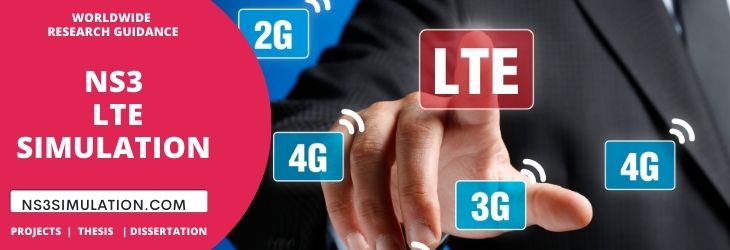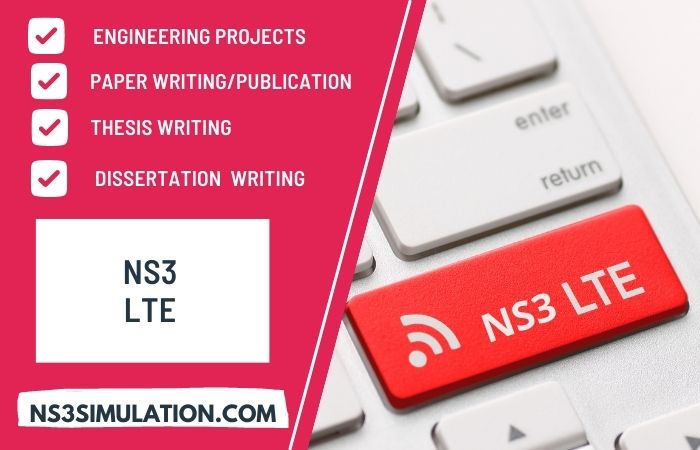LTE which stands for long-term evolution is the most famous wireless communication standard that is being used today. NS3 LTE simulation projects are being developed by engineers and researchers around the world. The following are the major applications of LTE that can be simulated by NS3,
- Streaming high quality video
- Downloading and storage of HD multimedia
- Rich voice calling
- VoIP
- Video conferencing in high quality
- Networking using mobile data
- Sharing application
- P2P file transfer
Through this article, we have given a complete overview of LTE using NS3 network simulation.
Our experts have jotted down the important aspects that are essential for researchers like you who are working on long-term evolution protocols. Always, our technical team is ready to support you throughout your research. Let us first start with the key features of LTE.
KEY FEATURES OF LTE
The characteristics of NS3 LTE are the reasons for its advanced functions. The following are the main features of LTE that you should consider
- Larger size of cell
- QoS increase
- Speed of transmission on the basis of QoS
- All Device support
- Reduced cost of processor load
- Latency (highly tolerance)
- Increased data rate is supported (for all users)
Due to these characteristics of the long-term evolution of standards used in wireless devices, it is commonly preferred by users. Your project can revolve around the best tool for the simulation of LTE systems. For this purpose, you need two things. First, you should know the different types of simulation tools for long-term evolution standards. And secondly, you need to have expert support and a well-experienced technical team to guide you to work with the tools. Now let us have some ideas on LTE simulation tools.
SIMULATION TOOLS FOR LTE
There are many simulation tools that can be used for various applications in LTE. The following are some of the major simulators that you can have as choices to choose from.
- MATLAB (LTE system toolbox)
- LTESim
- Qualnet
- OPNET (OPNET modeler)
- NS-3 or network simulator 3
- LTE module
- LENA module
- OMNeT ++
- SimuLTE
The module for LTE using NS3 configuration (through command-line arguments) can be based on the following.
- Passing simulation parameters directly
- NS-3 system configuration
Helper class modules, for example, the Ltehelper class, are present in the module. With these classes, specific components can be easily configured. We help researchers in working with these tools more efficiently. You can rely on us for your doubts and research support. We have got dedicated teams of experts for each and every research-oriented task. So we can guide you in all aspects of your research. Let us now understand the important characteristics of the NS3 LTE model.
KEY FEATURES OF NS3 LTE MODEL
The important features of the NS3 LTE model are listed below. By referring to them you can get a complete idea of why NS3 is the best simulator for LTE?
- E – UTRAN model with propagation loss model (channel model)
- Downlink and uplink packet scheduling is supported
- Data radio bearers are managed (QoS parameters)
- RLC instances and MAC queues managing
- UE and eNB – RRC entities
- PHY layer model (resource block level granularity)
- Management of Channel Quality Indicator (CQI)
- State of the art Adaptive Modulation and Coding (or AMC) scheme – for downlink
- User equipment and enhanced NodeB are implemented
We have helped the researchers in doing projects using ns3 simulation tools, especially for their LTE simulation project. So we have gone through the difficulties faced by researchers in the field. Our technical team has got us experience in designing LTE models. So you can reach out to us at any time regarding NS3 LTE design and simulation. Now let us have some ideas on designing LTE models.
HOW TO DESIGN A LTE MODEL?
The following steps form the basics of designing LTE model
- Shared uplink and downlink channels are used for simulation of an E – UTRAN interface (with several UE s and one eNB)
- LTE device implementation processes like modeling propagation is provided by the LTE model (along with MAC and PHY layers)
- The spectrum framework is extended to develop PHY layer
- The base class NS3 :: NetDevice is used to develop MAC model with additional features
- The LTE device consists of various entities like RRC, MAC, RLC etc. with dedicated classes
- In NS3 :: LteNetDevice, the LTE network devices basic functionalities are defined
- The different entities defined in the system are as follow
- RLC
- Mac
- Rrc
- LTE phy
The perfect integration of the module into the NS3 project is ensured. Each device is already attached to the IP/TCP protocol. It is also attached to all implemented applications like UDP client or server and trace-based applications etc. You can contact our technical experts regarding the details on methods and techniques used for LTE model designing. Now let us talk about building a mobility model with NS3.
HOW TO BUILD MOBILITY MODEL USING NS3 LTE?
Let us try to understand the building models like BuildingPropagationModel classes and MobilityBuildingInfo in NS3 simulation of LTE (in indoor and building nodes)
- // Header files
#include <ns3/mobility-building-info.h>
#include <ns3/buildings-propagation-loss-model.h>
#include <ns3/building.h>
- // Selection of Pathloss model
Ptr<LteHelper> lteHelper = CreateObject <LteHelper> ();
lteHelperàSet attribute (“PathlossModel”, StringValue (“ns3 :: BuildingsPropagationLossModel”));
- // Selection of EUTRA Band
Propagation working frequency selection is done using the NS3 attribute system. It happens with the help of UIEarfcn and DIEarfcn parameters. An example is stated below for your reference.
lteHelper ->SetEnbDeviceAttribute (“DlEarfcn”, UintegerValue (200));
lteHelper ->SetEnbDeviceAttribute (“UlEarfcn”, UintegerValue (10000));
Our engineers will give you all the details regarding coding and the execution tips of NS3 LTE simulation techniques. We will give you information from authentic and reliable research resources from which you can gain more knowledge and evidence for your project. Now let us see about the different transmission models of LTE using NS3
NS3 LTE TRANSMISSION MODELS
The seven transmission mode types of LTE is defined as follows
- MIMO Tx Diversity
- MIMO Multi – User
- Single antenna port
- MIMO Spatial Multiplexity Closed Loop
- SISO
- Closer Loop single layer precoding
- MIMO Spatial Multiplexity Open Loop
We are here to give your entire technical support along with a perfect coding experience. Contact our experts for more information on the NS3 LTE projects that we delivered. Now let us talk about the significant areas for doing LTE projects.
IMPORTANT RESEARCH AREAS FOR LTE PROJECTS
You can do LTE projects on the following topics. The list provided below includes the trending topics of research in the field.
- M2M communication
- Internet of things with increased efficiency
- Mobile edge computing
- Mobile networks (large scale)
- D2D communication
- Vehicular networks
- Ad hoc networks
We can provide you with all the necessary support and assistance for all the topics mentioned above. We also take complete responsibility for providing you the necessary support for any topic of your own interest. So you can reach out to us with more confidence. Your trust in us will never be let down. Contact us to have a great research experience. Now let us see about the major technologies in LTE.
4 MAIN TECHNOLOGIES IN LTE
The following for the four major LTE technologies everyone doing research projects in the field should be aware of.
- Accessing methods
- Single Carrier Frequency Division Multiple Access (SC – FDMA)
- Orthogonal Frequency Division Multiplexing Access (OFDMA)
- MIMO technology
- SU – MIMO
- MU – MIMO
- Duplexing methods
- TDD or Time Division Duplex
- FDD or Frequency Division Duplex
- Adaptive Modulation
- UL Modulations
- QPSK
- 16 – QAM
- DL Modulations
- QPSK
- 64 – QAM
- 16 – QAM
- UL Modulations
We have worked using all the above technologies. So we have enough reliable information on these techniques too. Connect with us so that we can get access to all such critical information needed for research. The research ideas in LTE networks are wide-ranging. As we have been guiding researchers in the LTE project for more than 15+ years we are well aware of the important research domains in it. We will provide you the details of such important research ideas in LTE networks below.
RESEARCH IDEAS IN LTE NETWORK
The following are the major and important research topics in long-term evolution standards. You can contact us for any details regarding the topic mentioned below.
- Algorithms for management of radio resource
- Load balancing
- Management of mobility
- QoE provisioning (end-to-end)
- LTE systems (cognitive)
- Prediction of mobility (multi – RAT)
- Routing path that is short
- Cell partitioning
- Clustering and optimization of handover
- Resource control and radio link
- Techniques of multiple access
- OFDMA
- SC – FDMA
- Strategies for scheduling resource and link
- MU – MIMO, MIMO Simulation and Massive MIMO
- Management of interference
- Sharing spectrum
- Management and allocation of resources
- Solutions for inter – cell interference coordination
- HetNets or Heterogeneous Network solutions
- Network solutions for multi – RAT
- UL LTE MAC and DL schedulers
- Design of adaptive antenna and internetworking
- Network intrusion and detection of anomaly
- Diagnosis of faults and packet scheduling
- Coding and adaptive modulation
- QPSK
- QAM
- Physical Downlink and uplink model
- Feedback for Channel Quality Indicator
- Optimal allocation of resource blocks
- Synchronization of downlink and uplink
- Intracellular and intercellular resources scheduling
We are providing research support for all the above topics. Our research support facility is one of the most famous in the world. The reliable online research guidance that we provide includes everything from the selection of the topic to the publication of the research papers in reputed research journals.
We extend our support in technical aspects too both in design and project implementation aspects. Now let us talk briefly about the future course of the ns3 LTE simulation models.
FUTURE DIRECTIONS OF NS3 LTE MODEL
The following aspects are those which have huge potential for future implementations using LTE features.
- PHY error model
- PDCCH control messages
- Uplink and downlink packet scheduler with standard packet transmission compliance
- It should exhibit throughput and fairness in allocation using simple round Robin scheme
- Efficient scheme of design for radio resource Management
- RLC entity with standard compliance
We will support you on both present and future research domains in LTE models. You can reach out to us and get the details that are necessary to do the best research projects in the field of NS3 LTE. Connect with us to enjoy your research career with the knowledge and experience of our technical team.


